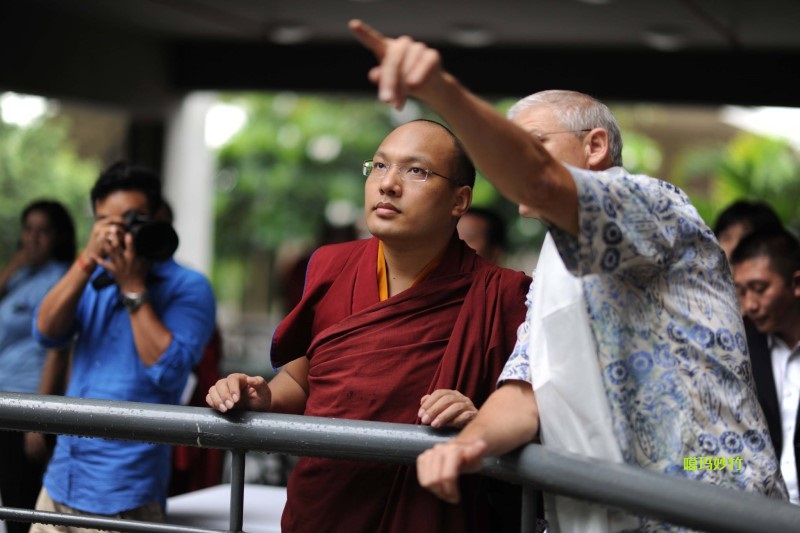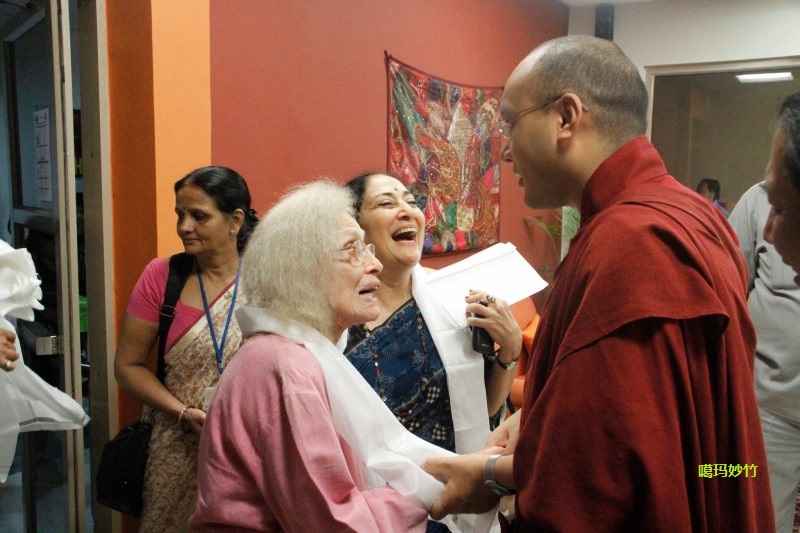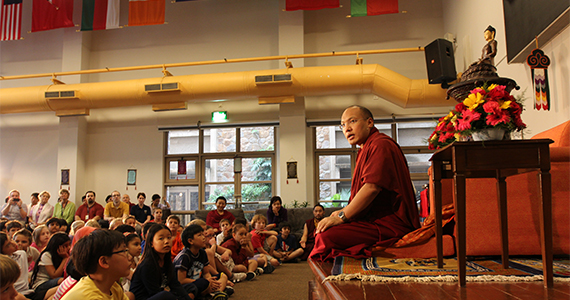法王新闻 | 2013年10月
『新德里』于美國大使館學校教导「正念覺察」
『New Delhi』Teaches Mindfulness to American Embassy School Students

時間:2013年10月04日下午 Afternoon of 4th Oct., 2013
地點:印度 新德里 New Delhi, India
教導美國學校學童以遊戲培養正念
It was with evident delight that His Holiness spent the afternoon of 4 October interacting with students, parents and staff at the American Embassy School in New Delhi. With this being his fourth such visit to the school, the Gyalwang Karmapa personally remembered many of the young students from previous years as they greeted him and approached for his blessings.
法王在新德里美國大使館學校,與師生和家長共度輕鬆愉快的午後時光。這是法王第四次訪問該校,根據過去的印象,法王仍然記得多位趨前問候並求賜加持的學童。

On his arrival at the school, a student first interviewed the Gyalwang Karmapa for a class project, asking him questions about his childhood and escape from Tibet. He then toured the school’s science labs, dropping in on an astronomy class and examining the telescope equipment.
法王甫進校園,便先接受一位學童的專訪。在這個為課堂計劃而做的訪談中,該學童請教了法王關於他的童年以及由西藏出走的故事。法王接著參觀科學實驗室,在天文學課堂中短暫逗留,檢視望遠鏡等設備。

Next the Gyalwang Karmapa headed to the school’s assembly hall, known as the Peace Hall, which was packed with 4th and 5th graders eagerly awaiting his arrival. The students, aged from 9–11 years, sang two songs for him on the theme of ‘shanti’ or peace. They later listened raptly as Ani Choying Drolma, the internationally renowned ‘singing nun’ from Nepal, performed live for them.
之後,法王前往該校稱為「和平會堂」的集會廳,廳中擠滿了引頸期盼的學童。這群年齡由9歲到11歲不等的四、五年級學童,首先向法王獻上以「和平」為主題的兩首歌曲,接著目不轉睛地欣賞尼泊爾籍享譽國際的「安尼歌手」安尼曲音.卓瑪(Ani ChoyingDrolma)的現場演出。
The young children asked the Gyalwang Karmapa a series of simple yet profound questions, seeking his wisdom on topics such as preserving the planet, preventing bullying, and finding inner peace.
緊接著,學童們就保護地球、預防暴凌、內在平靜等主題,向法王提出一系列簡單卻深刻的問題,希望獲得法王智慧甘露的澆灌。
“How can we be more mindful?” asked a young student.
「我們如何才能更具正念覺察(mindfulness)?」一名學童問道。
In response the Gyalwang Karmapa then skillfully devised a ‘mindfulness game’ for the children as a way to train in becoming more mindful. He invited them to take a single day, and to deliberately pay more attention to their actions over the course of that entire day.
法王善巧地提出一項「正念覺察的遊戲」,以幫助孩子增進正念覺察。法王邀請他們不妨挑選一天來做這個遊戲。在這一整天當中,他們必須特別注意觀察自己的行為:
“For the mindfulness game, in the morning you can make a plan,” he explained. “When you follow that plan you can take a white stone and put it in the ‘mindful’ column. And when you’re not being mindful, you can then take a black stone and put that in the ‘unmindful’ column. Then at the end of the day you can keep score and see how many levels you get through. You can examine yourself, and that way you will know how mindful you are being.”
「這個『正念覺察的遊戲』玩法是這樣:你在早上先做好一個計劃,然後觀察自己的行為。當你的行為符合計劃時,你就把一顆白色的小石頭放到『有正念覺察』的欄位。當你散逸而沒有照計劃進行時,你就把一顆黑色的小石頭放到『無正念覺察』的欄位。在這天結束前,分別計算得到多少顆的黑白石頭。透過這樣的方式,你就可以對自己進行檢驗,並且知道自己正念覺察的程度。」
In response to a question on how to be happy, the Gyalwang Karmapa replied that it was very easy. Children are very happy when they get something, he explained, because they are easily satisfied.
在回答一個「如何才能快樂」的問題時,法王表示,這很簡單。小孩只要得到東西就會非常快樂,這是因為他們很容易滿足:
“So I think the real spiritual instruction for being happy is to be satisfied with what you have. If you are, then that is the basis of being happy, and that is also the key point about being happy.”
「所以,我認為快樂的真實修持口訣是:對於你所擁有的,感到心滿意足。如果你做得到,那麼這即是快樂的基礎,也是快樂的要點。」
Later, after many of the students had left school for the day, the Gyalwang Karmapa continued his interactions with parents and staff who also sought his wisdom on wide-ranging topics.
在多數學生放學回家後,同樣渴望獲得法王指引的家長和教職員則留下來,繼續就廣泛的議題向法王請益。接續「正念覺察」的主題,法王為他們做進一步的闡述。
Continuing with the theme of mindfulness, the Gyalwang Karmapa elaborated further. Mindfulness is not something that we only do when we have a sudden emotional situation, he began. “We need to always, continually notice what is happening in our minds. We can say that being mindful is being in the present moment.”
法王指出,正念覺察並非只用在情緒衝動時:「我們必須無時無刻注意自己的起心動念。我們可以這麼說,具有正念覺察便是活在當下。」
“Normally we spend all day long working and doing things, and then when we come to the end of the day we don’t really know what we’ve done,” he said. “We don’t feel like we’ve tasted the flavor of anything that we’ve done, and that’s because we haven’t been in the present moment. So the feature of mindfulness is that we are being in the present moment, and are able to experience and taste it.”
「通常我們從早到晚忙忙碌碌,一天快結束時,卻不知道自己究竟做了些什麼,不覺得自己有嘗到任何所做的滋味,這是因為我們沒有處在當下。因此,具有正念覺察的特徵即是處於當下,能夠品嘗、體驗到當下的所作所為。」
He responded to a question on how artists can help keep their creative spirit alive.
“I think that drawing is actually really connected with mindfulness,” he said, “because as we’re drawing then our minds go along with what we’re drawing. When the mind and the drawing go along together, then our minds become more colorful, and our minds also have more beauty. I feel that this brings some peace.”
對於藝術家如何保持創造力的問題,法王回答:「我認為繪畫實際上與正念覺察緊密相連,因為作畫時,我們的心跟著我們所畫的內容走。當心與作畫並行時,我們的心會變得更美、更多彩。我覺得這能帶來一些祥和。」

Late in the afternoon a group of 3 giggling young elementary school students snuck back into the hall and approached the Gyalwang Karmapa for a blessing—their second that day. ‘Again!?’ he admonished them jokingly, before gently placing the khatas around their necks. Their delighted peals of laughter echoed throughout the Peace Hall as they ran away home, filled with the Gyalwang Karmapa’s blessings.
傍晚時分,三個小學童躡手躡腳地轉回集會大廳,攏向法王尋求第二次加持。「怎麼又來了呀?!」法王假裝呵斥他們,一邊溫柔地笑著往他們的頸項掛上哈達。如願以償的三小童高興地飛奔回家,他們穿堂而過的咯咯笑聲在「和平會堂」中迴盪良久。
网页修改记录:2022年01月07日,此处新建基本网页,放置YOUTUBE视频链接;2024年05月31日,添加图片、中英文本,纠正YOUTUBE错误链接。
Youtube 视频
